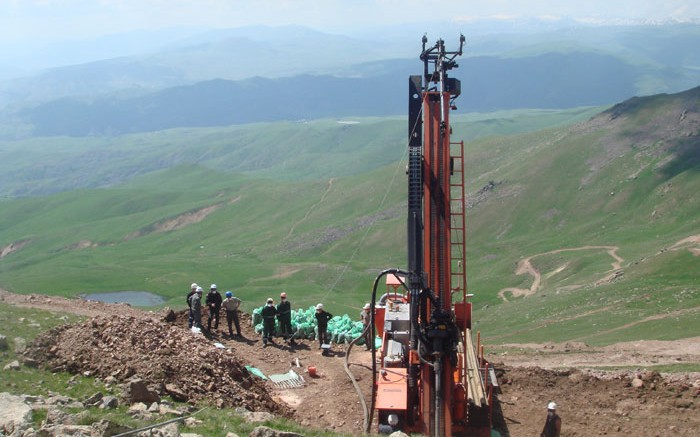VANCOUVER — Shares in Lydian International (TSX: LYD) surged 25% on news that the Armenian government had approved a new location for the heap-leach facility at the compnany’s proposed Amulsar gold mine in the country, where development was thrown into question in July when the expansion of a protected watershed area rendered Lydian’s previous mine plan invalid.
In the first half of the year Lydian had been working away at Amulsar, calculating a new resource and advancing a 40,000-metre drill program, while also fine-tuning its updated feasibility study, which the company planned to release in the third quarter. Lydian had already been advancing Amulsar for seven years, and, with the new-and-improved feasibility study almost complete, the company had finally been close to making a development decision.
Then came some unexpected news: the Armenian government had modified the area defined as the “catchment basin” for Lake Sevan, the country’s largest freshwater resource, and the protected area suddenly encompassed the proposed location for the Amulsar heap-leach facility.
On the news, Lydian’s share price — which had already slid 20% since the start of the year — lost more than 30% in a day.
The company got in touch with the Armenian authorities, who organized a working group to study the problem. With no other choice, Lydian announced its feasibility study update would be delayed and got working on negotiations.
That effort has paid off. The corporate and government members of the working group agreed that Lydian could apply to build a heap-leach facility in a valley 4 km southwest, where the group concluded that an operation of that sort would not conflict with any national laws.
“It’s been about a two-month process, in which members of the government and from our technical team reviewed all possible alternatives for the facility, and have now settled on one,” Lydian’s president and CEO Tim Coughlin said in an interview. “The whole process, I think, has brought Lydian and the government much closer together. We understand each other’s issues and better understand what we’re trying to achieve out of this project, so all in all it’s been quite a positive process.”
The valley is 7 km from the proposed Amulsar pits and offers potential as a valley-fill facility. Lydian’s engineers are developing a detailed plan for the location, which Lydian says provides ample room for ore stacking and requires less preparatory earthworks than the original facility. Coughlin says he expects costs for the facility to be in line with earlier estimates.
Lydian is already working at the site, completing geotechnical drilling and trenching. The company is also examining alternatives for crushing, conveying and waste-rock handling. Management will review all options before year-end, which should help Lydian complete its updated feasibility study in next year’s second quarter.
Most of the mine plan was unaffected by expanding the watershed-protection area, which is officially known as the “Vorotan-Sevan Water Tunnel Immediate Impact Zone.” Mineral processing is prohibited in the zone, but there are no restrictions on mining, crushing or milling.
Regardless, the new feasibility study is expected to offer some changes compared to the previous study, which was completed in 2012. The study assumed the mine would churn through 5 million tonnes per year for the first four years, until an expansion doubled throughput to 10 million tonnes per year for the next eight years.
As part of a study to optimize its crushing circuit, Lydian assessed building a 10-million-tonne-per-year facility from the start. That study identified operational and financial benefits to the larger operation, so the new feasibility will assume a full build-out.
The study will encompass a new resource estimate, completed in March, that increased the deposit’s ounces and confidence. The three deposits at Amulsar — which include the adjacent Tigranes and Artavasdes zones, and the nearby Erato zone — now contain 70.5 million measured and indicated tonnes grading 1.04 grams gold per tonne, plus 58 million inferred tonnes averaging 0.93 gram gold. Combining all three resource categories gives a total contained gold count of 4.1 million oz.
Amulsar is in southern Armenia, 170 km south of Yerevan. The gold at Amulsar comes in the form of high-sulphidation epithermal mineralization. The deposits are open at depth in most directions. Lydian intended to probe for further mineralization at depth with its drill program this year, but challenging ground conditions made for slow progress.
The program still produced some interesting results. At Tigranes, for example, hole 505 returned 221 metres grading 1.2 grams gold. The bottom 92 metres of this intercept came from beneath the current pit shell. Over at Erato, hole 522 targeted mineralization beneath the pit shell to the southeast and returned 180 metres grading 1.26 grams gold, ending in mineralization. Meanwhile, hole 517 was drilled on the northwest side of Erato and intersected 68 metres of 1 gram gold.
The deposits at Amulsar sit at or near surface, and within hills, which makes the mineralization easy to access. The last feasibility study predicted a 2.2-to-1 ratio of waste to ore over the mine’s life. The study also predicted Amulsar could produce an ounce of gold for US$468.50 on average over its 12-year mine life, and generate a 27.7% pre-tax internal rate of return.
News of the preliminary approval for Amulsar’s new leach-facility location added 25% to Lydian’s share price, lifting it from a 52-week low of 57¢ to 71¢. A year ago LYD shares were worth $2.35. Lydian has 130 million shares outstanding.


Be the first to comment on "Lydian rebounds on heap leach approval"